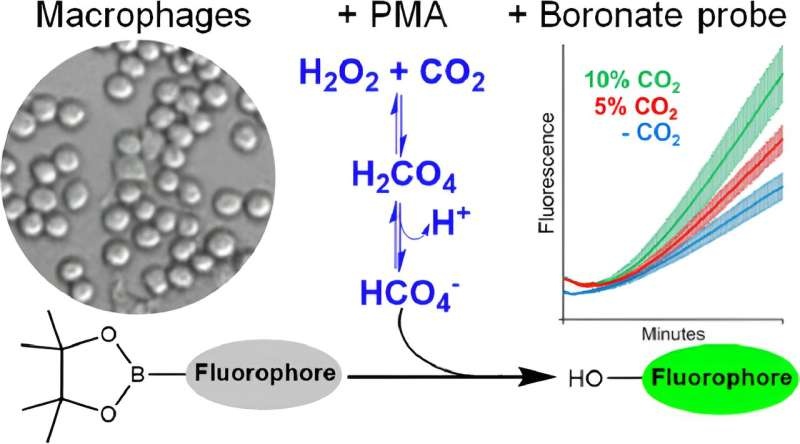Scientists created a revolutionary technique to find peroxymonocarbonate (POM), a strong oxidant generated by the reaction of carbon dioxide (CO2) and hydrogen peroxide, in cells. This finding has now provided new insight into the dangers of high CO2 levels in our surroundings, as well as in our organisms.

Deciphering the Mysteries of Peroxymonocarbonate
Peroxymonocarbonate is a sneaky compound living inside of our cells and impacting our health, flying under the radar. The powerful oxidant is created when an otherwise typical molecule in our bodies, hydrogen peroxide, collides with an even simpler byproduct of metabolism: carbon dioxiode.
Because cell concentrations of the species are so low and it is made slowly, for years its presence in cells was thought impossible. Finally, a team of scientists at the University of São Paulo’s Chemistry Institute (IQ-USP) in Brazil has devised a method for tracking down this elusive compound.
By using highly fluorescent molecular probes they were able to detect peroxymonocarbonate was present in cells, especially ones called activated macrophages — immune cells that produce high levels of many different oxidants. In the presence of CO2 and hydrogen peroxide, they do show for some emission of peroxymonocarbonate, which indicates clearly a potential for cellular biological processing and thus an interest in health impacts.
CO2 & Cellular Disfunction: The Wake Up Call
Not only does it wam our planet climate but also disturbs how our cells work. Here, CO2 reacts with a byproduct of our own metabolism – hydrogen peroxide – to form peroxymonocarbonate, as the study outlines.
But this finding is worrying because cities have been associated with numerous physiological problems linked to rising levels of city carbon dioxide. The process by which CO2 wreaks its toxic effects has remained a mystery that these new results shed some light on, as they point to peroxymonocarbonate as a suspect in this equation.
It was found that peroxymonocarbonate is key to cell proliferation, the redox signaling mechanistic pathway, and cellular pathology for instance. SUMOylation is the covalent conjugation of a small ubiquitin-like modifier (SUMO) to lysine residues in target proteins and plays versatile roles in cellular processes including activation of redox-responsive gene transcription caused by stress-induced peroxymonocarbonate formation. However, if the formation of peroxymonocarbonate is excessive it can lead to irreversible cell damage.
This discovery may be particularly important because peroxymonocarbonate signal seems to be linked to one of the putative type of intermediates in the diseases caused by higher CO2 concentration. With the continuing rise of CO2 levels, we cannot afford to overlook the potential health ramifications of this powerful oxidant.
Conclusion
This novel system of identifying peroxymonocarbonate in cells is a milestone towards evaluating the effect of high CO2 levels to human health. Revealing how this powerful oxidant plays a part in cellular function and dysfunction sets the stage for exploring how CO2 harms human life. With climate change and CO2 levels rising, the researchers said their work underscores the need to think about how environmental changes might affect our overall sense of cell and physiological health.
